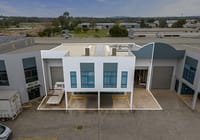
Hale Capital seeks $300m for ‘infill’ warehouse play
Multistorey warehouse pioneer Hale Capital Partners is looking to ride the wave of strong demand for last-mile logistics facilities generated by the growth of e-commerce with a $300 million equity raising.
Funds raised for the Hale Core Plus Logistics Mandate will focus on securing established warehouse sites – known in the industry as “infill” sites – close to major urban areas on the east coast, where it can develop new facilities, including multilevel logistics hubs.
Partnering with the likes of Oxford Properties, LaSalle Investment Management and Warburg Pincus, Hale has 13 assets under management and a $1.4 billion development pipeline, which it hopes to grow to $4 billion over the next two years.

Projects under construction or in planning include some of Sydney’s first multistorey facilities. A warehouse in Matraville in the eastern suburbs (undertaken in partnership with LaSalle) was sold to Boston-based Cabot Properties for about $145 million last year.
Also last year, Hale kicked off development on a 37,500sq m multilevel project at 339 Horsley Road, Milperra, in the south-west, while in March, Hale unveiled a 40,000sq m multistorey project in Lidcombe, due to be completed in early 2026.
In total, Hale has about 250,000sq m of multistorey warehousing in the pipeline, making it the biggest player in a sector expected to account for about 15 per cent of all new stock completed between now and 2027,
“As leaders in the development of multilevel warehouse space in Australia, we have been working to create products which suit the infill markets which we operate in, to facilitate efficient and sustainable last-mile solutions for our customers,” said Kenji Fukuda, head of development at Hale.
Hale was founded in 2021 by Robert McMickan and Nicholas Bradley, former executives of Mirvac and Goodman respectively.
Its latest equity raising comes as a new report from Cushman & Wakefield shows infill industrial markets are significantly outperforming the wider market in terms of occupancy levels and rental growth.
The report also identifies the infill sector, where the average age of a warehouse is 40 years, as ripe for redevelopment into modern facilities. Many of these sites – especially in Sydney, where land values are high – could be converted into multistorey hubs.
For east coast infill industrial markets, the Cushman report found the current vacancy rate was just 0.7 per cent, compared to 1.3 per cent for non-infill markets.
This lower level of vacancy combined with strong demand for warehouse space resulted in prime rents in infill markets jumping 27.4 per cent last year, significantly above the 15.8 per dent recorded for non-infill markets over the same period.
Looking ahead, Cushmans expects this outperformance to remain.
“At a national level, prime rents are forecast to grow by about 6 per cent in 2024, while select infill markets are expected to record growth closer to 8.5-10 per cent,” the real estate firm said.
“The catalyst behind this outperformance is the subdued supply pipeline. Over the next three years, just 13 per cent of new supply will be in infill markets, and for markets like Sydney, this is increasingly through multilevel developments.”
As a result of this outperformance, Tony Iuliano, head of logistics and industrial at Cushman & Wakefield, said there was outsized investor demand for infill assets.
“Transaction activity for infill assets has leapt from 39 per cent of all industrial deals in 2020 to 60 per cent in 2023, and occupiers continue to favour their location and access benefits,” he said.
“However, supply of infill assets across the east coast to 2026 is expected to run at around 13 per cent of available stock, creating a shortfall that is set to drive rents and investor competition higher.”











